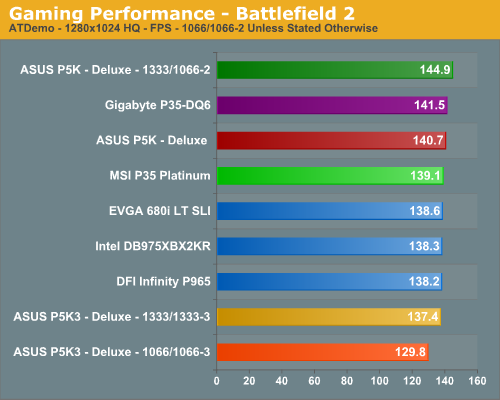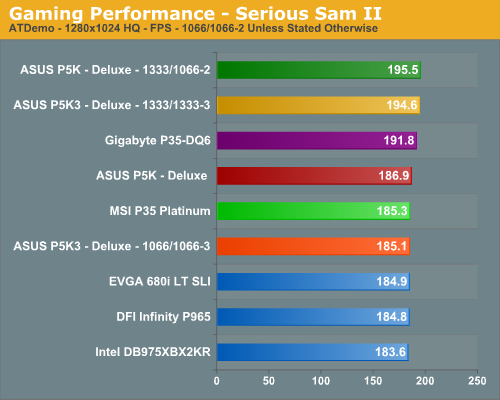Intel P35: Intel's Mainstream Chipset Grows Up
by Gary Key & Wesley Fink on May 21, 2007 3:45 PM EST- Posted in
- CPUs
Gaming Performance
As usual, gaming performance was tested with a variety of current games. We ran benchmarks with our standard 1280x1024 resolution with all games set to High Quality mode. Given the number of users that run 19" LCDs these days, 1280x1024 represents one of the most commonly used resolutions. We will provide final CrossFire numbers in our P35 roundup.Battlefield 2
This benchmark is performed using DICE's built-in demo playback functionality with additional capture capabilities designed in house. When using the built-in demo playback features of BF2, frames rendered during the loading screen are counted in the benchmark. In order to get a real idea of performance, we use the instantaneous frame time and frames per second data generated from our benchmark run. We discard the data collected during the loading screen and calculate a result that represents actual game play. While DICE maintains that results over 100fps aren't always reliable, our methods have allowed us to get useful data from high performing systems.
During the benchmark, the camera switches between players and vehicles in order to capture the most action possible. There is a significant amount of smoke, explosions, and vehicle usage as this a very GPU intensive Battlefield 2 benchmark. We run Battlefield 2 using the highest quality graphics settings available in the video settings. The game itself is best experienced with average in-game frame rates of 40 and up.

Serious Sam 2
This benchmark is performed using Croteam's built-in demo capability in the Serious Sam II engine. We utilize the included Branchester Demo and capture the playback results using the Ctrl-~ function. The benchmark features a large number of combatants, explosions, and general mayhem. The benchmark is primarily GPU sensitive with the actual percentage of GPU/CPU/Audio activity being displayed during the benchmark run. We typically find this game is very playable at average in-game rates of 60 and above. We maximize all settings except antialiasing and anisotropic filtering within the general and advanced video settings.

F.E.A.R.
F.E.A.R. uses a built-in performance test that generates graphical test scenes based upon the actual game engine. This test consists of a couple of different action sequences, a stressful water flyby, and heavy use of shadows while traveling through hallways. F.E.A.R. is a very graphics intensive game and we switch all settings to maximum for both the system and GPU. During our testing of F.E.A.R., we noted that the "soft shadows" don't really look soft and the performance hit is drastic, so we disable this setting. An average frame rate for F.E.A.R. can dip drastically during game play and that is not good for a first person shooter but the game is still playable around 35fps although we prefer a solid 45fps.

Gaming Summary
We see the DDR3 setups struggling in the Battlefield 2 tests in a game that is both CPU and memory sensitive. The high latencies of our DDR3 systems are taking their toll in this game. Fortunately, in the CPU/GPU bandwidth hungry F.E.A.R., the DDR3 platforms have a slight advantage. Our Serious Sam 2 benchmark is CPU/memory sensitive and the increased bandwidth offered by the 1333FSB boards allows them to take the lead.










58 Comments
View All Comments
yacoub - Monday, May 21, 2007 - link
I think HardOCP's conclusion is pretty honest. These boards are a first gen DDR3 setup that has to transition well from DDR2. Performance will be similar, they will offer a few new decent hardware features, but beyond that for most folks they should stick with their P965 or 650i/680i boards and their speedy DDR2 and wait until around a year from now when DDR3 will start to appear that legitimately outperforms DDR2 in a noticeable way and hopefully by then is cost competitive with DDR2.Right now we can get 2x1GB matched pairs of decent PC6400 DDR2 for around (and under) $100. When DDR3 reaches prices like that they'll see more converts from the enthusiast crowd. Or when they start showing performance gains on the order of 15-25% over DDR2.
tomoyo - Tuesday, May 22, 2007 - link
I don't think anyone should be thinking about an upgrade from a p965 in the first place, you've already gotten a core 2 duo and are waiting for the next gen of penryn! Obviously the point of this motherboard chipset is for new buyers, especially people who do not have a core 2 duo in the first place. That is exactly what my situation is, I'm sitting on an amd platform still and looking into when a good chipset/cpu combo is out. The P35 is it for myself, I like the higher fsb overclock and full set of features, hopefully the price will come down quickly as well. Also it's finally gotten to a point where we can get a full set of sata devices with no ide involved...which eliminates the jmicron issue.Wesley Fink - Monday, May 21, 2007 - link
If we were buying a new board today it would be P35 - based on our test results and not our untested opinions. Gaming is faster, memory performance is faster (even with DDR2), and the 1333 processor bus gives current C2D owners a "free" 25% overclcok in most cases.We would likely buy a P35 that supports DDR2 memory, because there is a large price difference in DDR2 and DDR3 right now, and DDR2 is just as fast as DDR3 on the P35 at the same speed and timings - and DDR2 is faster on P35 than P965.
However, we already have our first samples of low-latency DDR3 in for testing. Recommending DDR3 will be about how fast we see price parity with DDR2 as it is definitely the memory of the future.
suryad - Tuesday, May 22, 2007 - link
Any ideas on when an SLI based P35 setup would be released? That is about the only thing that is holding me back from purhcasing a P35 mobo. I want SLI.yacoub - Monday, May 21, 2007 - link
"If we were buying a new board today "Right. And the HardOCP editorial was writing more for those of us who already own a fairly recent board and are wondering if the performance is significant enough to warrant another upgrade. Conclusion: it isn't.
You're both right, in other words. If you're buying a new board today, no major reasons NOT to buy a P35 unless it's a DDR3 one in which case DDR3 is cost prohibitive and offers little to no real performance benefit. If you already have a P965, 650i, 680i, etc, no reason to upgrade.
tomoyo - Tuesday, May 22, 2007 - link
Actually that's not true, according to Kyle, he's endorsing the P965 for all users, new or old. I think he's gotten far too distrustful for new products, especially when this one looks pretty promising. Since the P35 is more of an evolution than anything else, it's a good possibility that we'll get some pretty stable products right off the bat. And I'm of the opinion that a cheap 5% performance upgrade and mobo with full penryn voltage support is worthwhile at the right price for any new user. I do think it'll be a good idea to wait about a month and see if there is any fallout before diving in.Wesley Fink - Monday, May 21, 2007 - link
That was an editorial, not a review. There was not a single test result in that article.On the other hand, we are late to NDA because we got 3 new P35 boards on Friday, and we wanted to bring you real test results based on four motherboards. Our comments and conclusions are based on testing a large number of P35 motherboards, and both DDR2 and DDR3 memory on these boards.
michal1980 - Monday, May 21, 2007 - link
I know, but his conculsion was to get a mature p965, yours a p35. uggh.JarredWalton - Monday, May 21, 2007 - link
With the testing results provided here (and in our previous articles), we're comfortable in saying that P35 is already quite mature, particularly the ASUS boards. If you already have a P965 board there's not much reason to upgrade, but if you're buying a new board we would take a serious look at P35 offerings.TA152H - Monday, May 21, 2007 - link
I was seriously considering getting one of these boards, but I wouldn't even think about it after your review. What the heck is going on with the power use???? The improvement in performance, to me, is a lot less noticeable than the damn noise you'll have trying to evacuate the heat from the motherboard. What a disappointment. The interesting thing is, another site that ran the power use came in lower than the P965, so I'm really confused which is right. My gut instinct is, they are, because this is a 90nm chip with lower specified power use, but I'm sure you guys knew that and were just as confused and made sure your results were correct. I don't get it at all. It's really disappointing, but maybe with future revisions Intel will get the power down to normal levels.I now think supporting DDR2 was a mistake, sure it's good today, but prices for DDR3 will come down, and they would come down fast if Intel made it only DDR3 since memory makers would be very motivated to get their act together. Plus, you'd pay LESS for the chipset, and you'd pay less in electricity for it, and you'd pay less for the motherboards since they wouldn't need as extravagant a cooling solution on it (although, I may buy a MSI just to have that roller coaster. I'm not sure why they felt that design was necessary, but I feel like I need it now. ). So, sure, the cost right now of DDR3 would offset it, but that point will be crossed, and for the rest of the life of the chipset, people will be paying for something that is completely unnecessary and useless, which DDR2 support will be. The P965 would have been fine for legacy support, you don't NEED a P35, and for those folks that wanted it, DDR3 would be fine. Maybe the X38 will drop the dreaded DDR2 support since it's a high-end solution and doesn't need to be shackled with DDR2 support. I hope so.